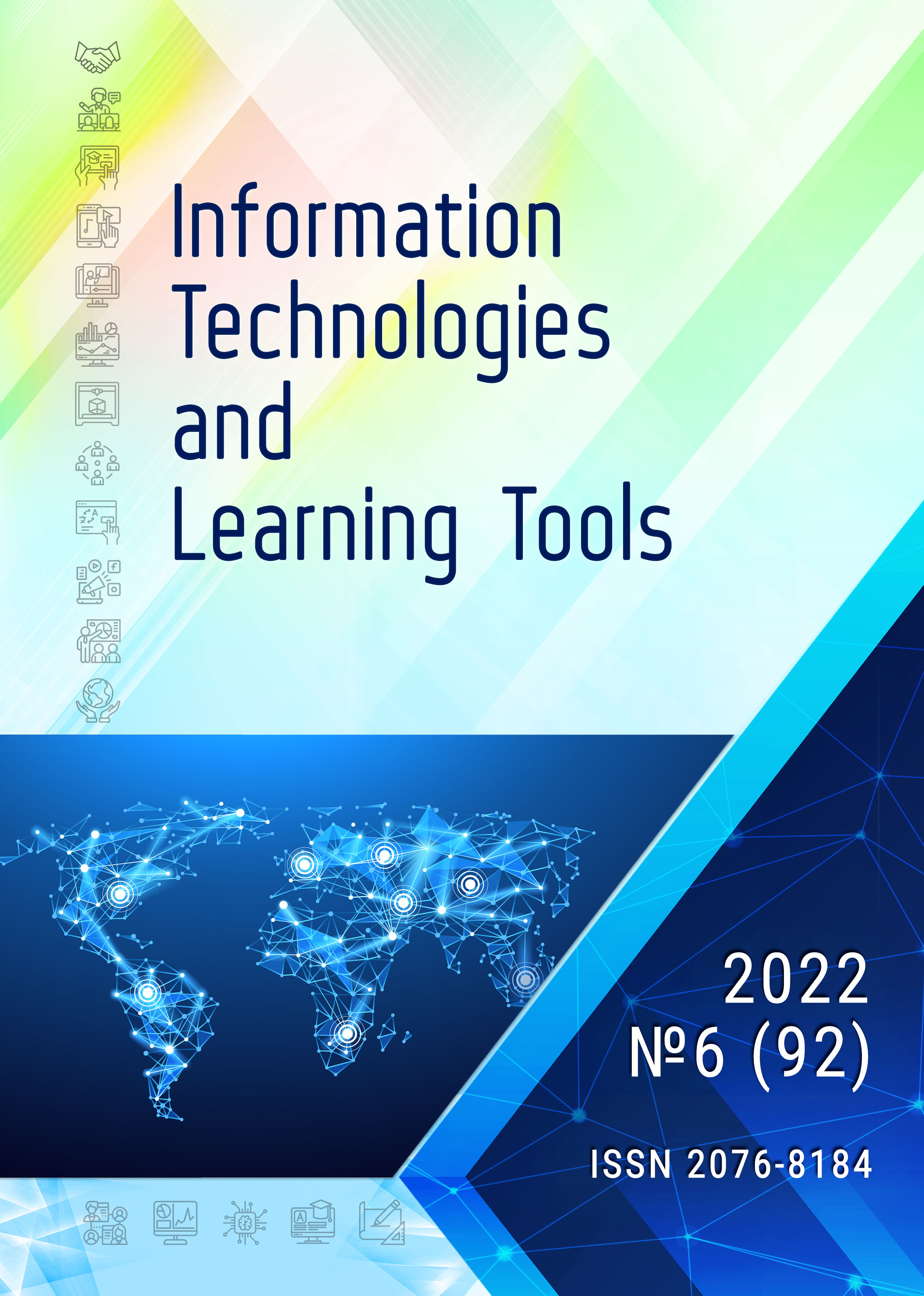Abstract
The article addresses the choice of pedagogical strategies for application of immersive technologies in foreign language teaching and learning, using the Japanese language as an example. The authors defined and substantiated the main pedagogical strategies using immersive technologies: inquiry-based approach, project-based learning, mixed learning, flipped learning, mobile learning, game learning, joint learning, and independent learning. A study was conducted on the aspects of application of immersive technologies by 3rd year students of the Education and Research Institute of Philology of the Taras Shevchenko National University of Kyiv during their educational projects. The students’ attitude to pedagogical strategies using augmented and virtual reality was analyzed. It has been determined that it is difficult for students to apply these technologies, because they do not have enough experience of using them in language learning. Nevertheless, these tools significantly help them in the formation and development of research skills, digital competence, expand their ability to use information and communication technologies in learning Japanese. In our further research, we plan to actively implement augmented and virtual reality in the teaching of the Japanese language to students using basic pedagogical strategies, especially through the inquiry-based approach and project-based learning, combined with other applicable pedagogical strategies - such as blended learning, flipped learning, mobile learning, game-based learning, collaborative learning and self-directed learning.
References
Muelas, E. Navarro, “Learning Strategies and Academic Achievement”. Procedia - Social and Behavioral Sciences, vol.165: pp. 217-221, 2015. https://doi.org/10.1016/j.sbspro.2014.12.625. (in English)
D. Sampaio, P. Almeida, “Pedagogical Strategies for the Integration of Augmented Reality in ICT Teaching and Learning Processes”. Procedia Computer Science, vol. 100, pp. 894– 899, 2016. https://doi.org/10.1016/j.procs.2016.09.240. (in English)
S. Li, Y. Chen, D. M. Whittinghill, & M. Vorvoreanu, “A pilot study exploring augmented reality to increase motivation of Chinese college students learning English”. In ASEE Annual Conference, Indianapolis, IN, 2014. doi: 10.18260/1-2-19977. (in English)
H. M. Lu, S. J. Lou, C.Papa, & C. C. Chung, “Study on influence of adventure game on English reading confidence, motive and self-efficacy”. In International Conference on Technologies for E-Learning and Digital Entertainment. Berlin, Heidelberg: Springer, 2011, pp. 430-434. doi: 10.1007/978-3-642-23456-9_77. (in English)
Frazier, Erin & Bonner, Euan & Lege, Ryan, “A Brief Investigation into the Potential for Virtual Reality: A Tool for 2nd Language Learning Distance Education in Japan”. 2. 211, 2019. https://www.researchgate.net/publication/333644601_A_BRIEF_INVESTIGATION_INTO_THE_POTENTIAL_FOR_VIRTUAL_REALITY_A_TOOL_FOR_2ND_LANGUAGE_LEARNING_DISTANCE_EDUCATION_IN_JAPAN. (in English)
C. L. Holden, & J. M. Sykes, “Leveraging mobile games for place-based language learning”. International Journal of Game-Based Learning, 1(2), pp. 1-18, 2011. doi: 10.4018/ijgbl.2011040101. (in English)
J. Barreira, M. Bessa, L. C. Pereira, T. Adão, E. Peres and L. Magalhães, "MOW: Augmented Reality game to learn words in different languages: Case study: Learning English names of animals in elementary school," 7th Iberian Conference on Information Systems and Technologies (CISTI 2012), 2012, pp. 1-6. (in English)
X. Huang, G. Han, J. He, et al., “Design and Application of a VR English Learning Game Based on the APT Model”. In 2018 Seventh International Conference of Educational Innovation Through Technology (EITT). 2018, 68–72. doi:10.1109/EITT.2018.00022. (in English)
X. Zhang, M, Zhou, “Interventions to promote ’learners’ intercultural competence: A meta-analysis”. International Journal of Intercultural Relations 71, 2019, pp. 31–47. doi:10.1016/j.ijintrel.2019.04.006. (in English)
M. Pedaste, M. Mäeots, L. A. Siiman, de T. Jong, van S. A. N. Riesen, E. T. Kamp, C. C. Manoli, Z. C. Zacharia, & E. Tsourlidaki, “Phases of inquiry-based learning: Definitions and the inquiry cycle”. Educational research review, 14, 2015, pp. 47-61. doi: https://doi.org/10.1016/j.edurev.2015.02.003. (in English)
M.A. Kuhail, A. ElSayary, S. Farooq, A. Alghamdi, “Exploring Immersive Learning Experiences: A Survey”. Informatics, 2022, 9, 75. [Online]. Available:https://www.mdpi.com/2227-9709/9/4/75 (in English)
J. Hu, “Gamification in Learning and Education: Enjoy Learning Like Gaming: By Sangkyun Kim, Kibong Song, Barbara Lockee, and John Burton”. Cham, Switzerland: Springer International Publishing AG. 2018, (hbk). ISBN 978-3-319-47282-9 (hbk). Br. J. Educ. Stud. 2020, 68, pp. 265–267. (in English)
Y. Udjaja, “Gamification Assisted Language Learning for Japanese Language Using Expert Point Cloud Recognizer”. International Journal of Computer Games Technology. 2018, pp. 1-12. doi:https://doi.org/10.1155/2018/9085179. (in English)
I. Dobroskok, N. Rzhevska, H. Ayyıldız, D. Zaimova, & G. Zheliazkov, “Game development software tools in higher educational institutions: experience OF Ukraine, Turkey and Bulgaria”. Information Technologies and Learning Tools, 78(4), 2020, pp. 90–104. doi:https://doi.org/10.33407/itlt.v78i4.3370. (in English)
C. Nerantzi, "The Use of Peer Instruction and Flipped Learning to Support Flexible Blended Learning During and After the COVID-19 Pandemic". International Journal of Management and Applied Research, vol. 7, No. 2, 2020, pp. 184-195. doi:https://doi.org/10.18646/2056.72.20-013. (in English)
H. Crompton, “A historical overview of mobile learning: Toward learner-centered education”. In Z. L. Berge & L. Y. Muilenburg (Eds.), Handbook of mobile learning, 2013, pp. 3-14. doi:https://doi.org/10.4324/9780203118764. (in English)
H. V. Tkachuk, “Features of implementation of mobile education: perspectives, benefits and shortcomings”. Information Technologies and Learning Tools, 64(2), 2018, pp. 13-22. doi:https://doi.org/10.33407/itlt.v64i2.1948. (in Ukrainian).
S.D. Brookfield, “Self-Directed Learning”. In: Maclean, R., Wilson, D. (eds) International Handbook of Education for the Changing World of Work. Springer, Dordrecht. 2009. doi:https://doi.org/10.1007/978-1-4020-5281-1_172. (in English)

This work is licensed under a Creative Commons Attribution-NonCommercial-ShareAlike 4.0 International License.
Copyright (c) 2022 Олена Гаєвська, Наталія Сороко


